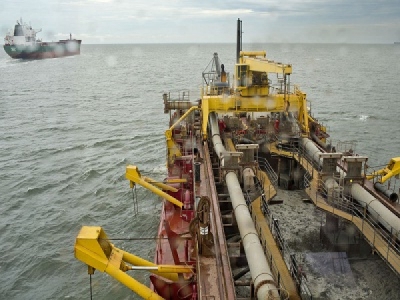
Posted on December 5, 2016
By Robert McCabe, The Virginian-Pilot
They’re viewed by local maritime-industry leaders as “must-haves” to secure the Port of Virginia’s future: Two big dredging projects that together could cost about $300 million.
One would deepen the port’s main shipping channels from 50 feet to 55 feet, giving it the deepest water on the East Coast.
The other would get portions of the Southern Branch of the Elizabeth River down to 40 and 45 feet, allowing vessels to carry more commodities to and from terminals in Chesapeake and Portsmouth.
On Thursday, a U.S. Army Corps of Engineers official briefed about 125 stakeholders on the status of the two projects at a yearly navigational summit focused on the mantra “wider, deeper, safer,” the strategic objectives for the port’s waterways for more than a decade.
Both projects – on separate tracks – have been in an initial, three-year study phase since June 2015, when leaders from the Army Corps and the Port of Virginia signed off on a pair of cost-sharing agreements that set the studies in motion.
On Thursday, it was report-card time, more or less.
The good news was that the Southern Branch project study process was expected to wrap up by its three-year deadline, in June 2018.
The so-called “55-foot project,” however, may need some more time to allow for more computer modeling related to the amount of “underkeel clearance” needed by the bigger ships on the horizon as well as channel widening.
“We should have a schedule early next year on how long the extension’s going to be,” Robert Pretlow, a Corps project manager, said in an interview.
“There’s a potential need for a delay and so it’s being evaluated with the Army Corps and us, as a co-sponsor,” John Reinhart, executive director and CEO of the Virginia Port Authority, said in remarks following the meeting on Thursday.
He said the parties are trying to keep any delay limited – perhaps six months.
Channel width is just as important as channel depth because ships are getting so large they can’t pass one another, he added: “You don’t want to set a one-way channel up for this port, because it just will bottle you up.”
Citing preliminary container volume figures for November, Reinhart said the port was up more than 16 percent from a year ago.
While ships able to carry more than 10,000 containers were part of that surge, 14,000 TEU-range vessels could be arriving in April, he added. A TEU is an industry-standard 20-foot unit.
Two big capital projects worth about $700 million are about to unfold at the port over the next three years – expansions at Norfolk International Terminals and Virginia International Gateway, the port’s two big container facilities.
“We’re doing everything we can to build the landside portion of this,” Reinhart said in closing remarks at the meeting on Thursday.
He ended with a plea that those listening would work together to help speed up the “wider, deeper, safer” initiatives:
“Help us to get it done sooner, because this pace is too slow; we have to accelerate our track.”
The port has had congressional authorization to dredge to 55 feet since 1986.
The Army Corps is reviewing the project again, however, to determine optimum depths and widths based on current and projected traffic.
Assuming that Hampton Roads’ 55-foot project needs no further act of Congress to move ahead, completion of the dredging would still be years away – even in a best-case scenario, maybe a decade.
Source: The Virginian-Pilot





